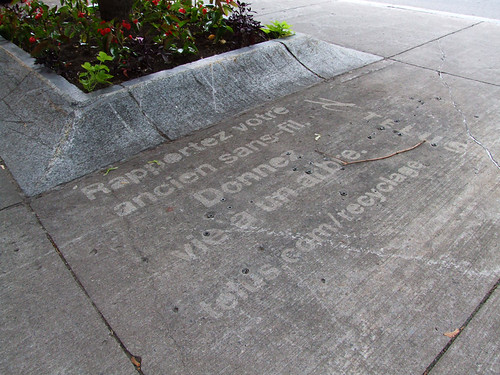Guerilla advertising in the form of sidewalk stencils is nothing new—Julie’s post below details the city of Portland’s lawsuit against one company that made persistent use of this medium, which is illegal—but a series of Telus ads I saw recently on McGill College Avenue struck me as unusual. Instead of being painted on the surface of the sidewalk, the advertisements are actually created by removing dirt from a particularly grimy section of it.
As with most forms of guerilla advertising, this one has its origins in street art: in this case, a peculiar form of it known as “reverse graffiti,” in which art is created by selectively cleaning dirt from walls, sidewalks and signs, like a more elaborate version of drawing something on a dirty car window. A couple of years ago, the British artist Paul Curtis, also known as Moose, made use of this technique to create some remarkable pieces of art on the streets of Leeds and other English cities. To fund his activities, he also sold his services to companies such as Microsoft and Smirnoff. Leeds city council wasn’t too pleased with Curtis’ work; it declared it to be vandalism and tried to force him to clean the walls he had supposedly defaced.
“Leeds residents want to live in clean and attractive neighbourhoods, and expect their streets to be free of graffiti and illegal advertising,” one Leeds official said in 2007. “We also view this kind of rogue advertising as environmental damage and will take strong action against any advertisers carrying out such campaigns without the relevant permission.” While such a tough stance might be seen as admirable by some, it smacks of hypocrisy: if the city had kept its property clean to begin with, it wouldn’t have been possible to create reverse graffiti. Needless to say, passing a law prohibiting the unauthorized cleaning of public property could be problematic, not to mention absurd.
So what to make of the Telus ads on McGill College? Unlike Paul Curtis’ work, which had artistic merit, these have none. But they aren’t necessarily illegal, and if they city wants to clean them away they will only be doing a job that it should already have done.

Reverse graffiti mural created by Moose in San Francisco as part of a campaign to raise environmental awareness. Photos courtesy Inhabitat



6 comments
I actually think these reverse ads are insidious. No one expects the city to blast incidental dirt off urban sidewalks. It’s unnecessary — it is where we walk, after all — and would be a huge waste of resources. So these companies are taking painting the city into a corner. Do nothing and they’re allowing companies to take advantage of citizens.
Moose’s art was gorgeous and innovative — it’s when he sold himself to companies that he crossed the line between street art and shilling. People like him serve to blur the line between ad creep and legit art in the public mind, and cause cities to crack down on both. He should have known that would happen.
I think it is important to wonder what chemicals he is using to clean the sidewalk.
If I had to guess, I would probably guess it was hydrochloric acid, which is available as “Muriatic Acid” at hardware stores, or sometimes just “driveway cleaner.”
If it’s just water, it is hard to make the environmental damage claim.
“Needless to say, passing a law prohibiting the unauthorized cleaning of public property could be problematic, not to mention absurd.”
The difference between cleaning a sidewalk and selectively cleaning small portions so to spell out an advertising slogan should be clear to anyone except those who want to play silly buggers with semantics.
Unfortunately for bbpsi, Potter Stewart’s rules don’t apply and lawyers are rather big on semantics.
This is great for street art and advertising. 3 chers for capitalist innovators!
They are not using chemicals to apply the process. It is done using a stencil and power washer with cold water.
I believe this is actually not such a bad thing, and cities should permit the process, perhaps even take a license fee to help combat illegal Vinyl posters, which do not degrade in the environment.
Graffiti Rocks.